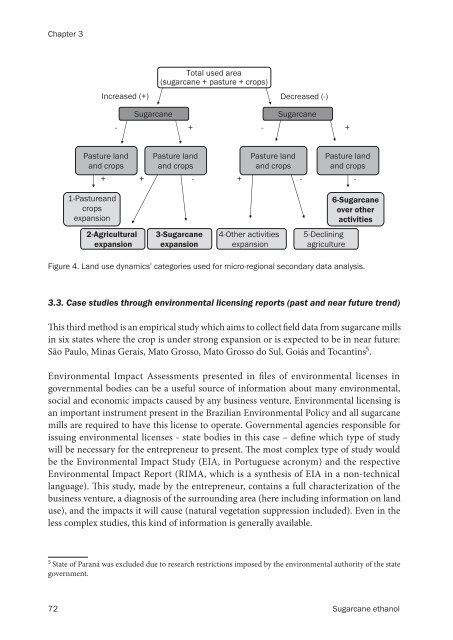Sugarcane ethanol: Contributions to climate change - BAFF
Sugarcane ethanol: Contributions to climate change - BAFF
Sugarcane ethanol: Contributions to climate change - BAFF
You also want an ePaper? Increase the reach of your titles
YUMPU automatically turns print PDFs into web optimized ePapers that Google loves.
Chapter 3<br />
1-Pastureand<br />
crops<br />
expansion<br />
Figure 4. Land use dynamics’ categories used for micro-regional secondary data analysis.<br />
3.3. Case studies through environmental licensing reports (past and near future trend)<br />
�is third method is an empirical study which aims <strong>to</strong> collect �eld data from sugarcane mills<br />
in six states where the crop is under strong expansion or is expected <strong>to</strong> be in near future:<br />
São Paulo, Minas Gerais, Ma<strong>to</strong> Grosso, Ma<strong>to</strong> Grosso do Sul, Goiás and Tocantins 5 .<br />
Environmental Impact Assessments presented in �les of environmental licenses in<br />
governmental bodies can be a useful source of information about many environmental,<br />
social and economic impacts caused by any business venture. Environmental licensing is<br />
an important instrument present in the Brazilian Environmental Policy and all sugarcane<br />
mills are required <strong>to</strong> have this license <strong>to</strong> operate. Governmental agencies responsible for<br />
issuing environmental licenses - state bodies in this case – de�ne which type of study<br />
will be necessary for the entrepreneur <strong>to</strong> present. �e most complex type of study would<br />
be the Environmental Impact Study (EIA, in Portuguese acronym) and the respective<br />
Environmental Impact Report (RIMA, which is a synthesis of EIA in a non-technical<br />
language). �is study, made by the entrepreneur, contains a full characterization of the<br />
business venture, a diagnosis of the surrounding area (here including information on land<br />
use), and the impacts it will cause (natural vegetation suppression included). Even in the<br />
less complex studies, this kind of information is generally available.<br />
5 State of Paraná was excluded due <strong>to</strong> research restrictions imposed by the environmental authority of the state<br />
government.<br />
Increased (+)<br />
Pasture land<br />
and crops<br />
+ + - +<br />
-<br />
-<br />
2-Agricultural<br />
expansion<br />
Total used area<br />
(sugarcane + pasture + crops)<br />
- + -<br />
+<br />
Pasture land<br />
and crops<br />
3-<strong>Sugarcane</strong><br />
expansion<br />
Pasture land<br />
and crops<br />
4-Other activities<br />
expansion<br />
Decreased (-)<br />
<strong>Sugarcane</strong> <strong>Sugarcane</strong><br />
Pasture land<br />
and crops<br />
5-Declining<br />
agriculture<br />
6-<strong>Sugarcane</strong><br />
over other<br />
activities<br />
72 <strong>Sugarcane</strong> <strong>ethanol</strong>












